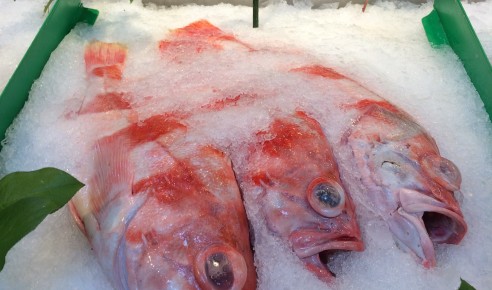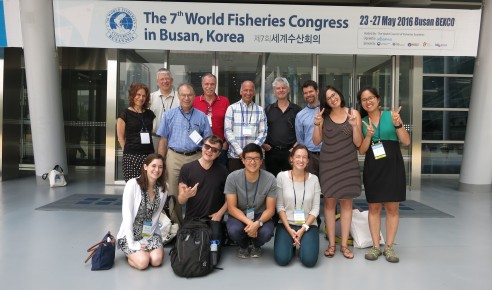André Punt visited the College of Marine Sciences at Shanghai Ocean University (SHOU) during April 2017. The aim of the visit was to establish collaborations with faculty and students at SHOU. The faculty at SHOU represent The People’s Republic of China at many Regional Fisheries Management Organizations such as the Commission for Conservation of Antarctic Living Marine Resources (CCAMLR) and the Western and Central Pacific Fisheries Management Commission (WCPFC). André’s host in Shanghai, Dr. Xinjun Chen, the Dean of the College of Marine Sciences, is also the Chief Scientist for China’s distant-water fisheries. While in Shanghai, André gave talks on Management Strategy Evaluation and rebuilding of fish stocks in the US. He also got to see something of the city of Shanghai between meetings and lectures
Author Archives: Kelli Johnson
SAFS in the News: Mislabeled seafood may be more sustainable, new study finds
SAFS grads, including Punt Lab member Qi Lee, are featured in UW Today. Qi Lee started the project during the SAFS Research Derby during its inaugural year prior to starting her degree.
‘With seafood, what you see is not always what you get.
It’s no secret that mislabeling is rampant around the world. Recent studies estimate up to 30 percent of seafood served in restaurants and sold in supermarkets is actually something other than what is listed on the menu or label.
Why mislabeling happens is a little squishier. Fraud, human error or marketing ploys — combined with an often multicountry traverse from boat to restaurant — make it possible you are eating a different fish than what’s on the menu.
A University of Washington study is the first to broadly examine the ecological and financial impacts of seafood mislabeling. The paper, published online Nov. 2 in Conservation Letters, finds that in most cases, mislabeling actually leads people to eat more sustainably, because the substituted fish is often more plentiful and of a better conservation status than the fish on the label.’
Excerpt by Michelle Ma, UW Today
SAFS at 2016 World Fisheries Congress
Fourteen UW students and faculty, together with countless more SAFS alumni attended the 7th World Fisheries Congress in Busan, South Korea, this May. The theme for this year was “Challenges to Sustainable Fisheries and Safe Seafoods”, a topic very relevant to our lab. There were 36 sessions at this congress, and approximately 1400 attendees. Two members of the current Punt lab were in attendance – Dr. Punt and MS student Lee Qi – as well as many former lab members, including Dr. Jim Thorson and Dr. Athol Whitten. Dr. Punt gave a talk titled “An Honest Appraisal on Stock Assessment”, and Lee Qi gave a presentation about her thesis work at SAFS.
Optimizing otoliths sampling design in fishery-independent surveys for stock assessments
Dr. Gwladys Lambert1
1AFSC
May 31, 2016 9:00 (PST): FSH 105
Optimizing otoliths sampling design in fishery-independent surveys for stock assessments
The sampling design of composition data can have a major impact on our perception of the stock status and the estimated reference points for management. Composition data as sampled from bottom trawl surveys are famously clustered which creates major challenges when it comes to estimating length and age composition of the population of interest and in particular with respect to effective sample size/data weighting in stock assessment models. Here I present the approach I have been exploring in order to prepare a simulation framework to compare otoliths sampling strategies and their impact on stock assessment outputs. First I will talk about the questionnaires I have designed as part of the Otolith Sampling Size Working Group that aimed at informing the development of an operating model. Then I will discuss the implications of removing age data in data rich stock assessments based on a couple of examples and I will show some early simulation work using Stock Synthesis and developments from the R package ss3sim. Ss3sim developments include the addition of an option to test for the effect of ageing error on stock assessment outputs. The main focus will be on another option I have been experimenting with which aimed at simulating the sampling of clustered length data (that resemble real survey data) from random or length-stratified sampling in order to investigate the effect of different sampling strategies on the effective sample size estimated in stock assessments. I will also briefly talk about the Stock Synthesis model for GOA Pacific Ocean Perch I have been working on in order to use in the simulations described above.
Coupled biophysical/individual-based models: can they inform recruitment, stock assessment and/or fishery management? DisMELS lessons from the GOAIERP
Dr. William T. Stockhausen1
1AFSC
May 24, 2016 9:00 (PST): FSH 105
Coupled biophysical/individual-based models: can they inform recruitment, stock assessment and/or fishery management? DisMELS lessons from the GOAIERP
One of the key hypotheses underlying NPRB’s recent Gulf of Alaska (GOA) Integrated Ecosystem Research Project (IERP) was that year-class strength for the five commercially- and ecologically-important groundfish stocks at the focus of the project was determined by success or failure in running the early life, pelagic “gauntlet” from adult spawning areas to young-of-the-year nursery areas. As part of the multi-institution, multidisciplinary effort to address this hypothesis for pollock, Pacific cod, arrowtooth flounder, sablefish, and Pacific ocean perch, a group of modelers (including the author) constructed early life, coupled biophysical/individual-based models (CBP-IBMs) for each stock. For marine species with pelagic early life stages, CBP-IBMs provide one of the best approaches to synthesizing disparate information on individual life stages (e.g., eggs, larvae) and environmental variability into an integrated picture of early life processes. Among our goals for these models was to be able to improve current stock assessments and enhance fishery management by identifying the critical drivers of recruitment variability and hindcasting (or potentially forecasting) recent trends in recruitment for the five focal species. In regard to identifying critical drivers of recruitment variability, I think we can say that variability in physical transport, i.e. where young-of-the-year end up, is less important to recruitment variability than what happens along the way. However, in regard to predicting recruitment variability itself, we were certainly not terribly successful—except perhaps for pollock, the most data-informed of all the IBMs. As an extended introduction, I’ll briefly 1) introduce the concepts behind CBP-IBMs; 2) discuss DisMELS (the Dispersal Model for Early Life Stages), a framework for creating and running CBP-IBMs; and 3) review the five species-specific IBMs created for the GOAIERP. Then I’ll discuss results from the models and what they tell us about early life processes in the GOA. Finally, I’ll present a couple of practical suggestions for some “best practices” using these types of models.
Simulation Testing Hierarchical Multi-Stock Assessment Models for a BC Flatfish Complex
Samuel Johnson1
1 Simon Fraser University
Novermbet 22, 2016 9:00 (PST): FSH 203
Simulation Testing Hierarchical Multi-Stock Assessment Models for a BC Flatfish Complex
I am interested in finding the conditions that favour joint stock assessments for multiple flatfish species using hierarchical models. Hierarchical multi-level modeling approaches are being increasingly applied in stock asssessment to share information across stocks and species. These so-called “Robin Hood” approaches borrow information from data-rich to potentially improve assessments for data poor species; however, little research exists to demonstrate the boundary conditions where hierarchical approaches outperform single species models. In this talk, I present a hierarchical surplus production modeling approach for a multi-species flatfish complex in British Columbia, Canada. If applicable, the hierarchical modeling approach could help provide more up-to-date assessments for species last assessed in the 1990s!
The genetic basis of pathogen resistance across outbred salmon populations: a comparative analysis using Random Forest
Dr. Kerry Naish1, Dr. Marine Brieuc1, Charles Waters1, Dr. Maureen Purcell2
1SAFS
2Western Fisheries Research Center, USGS
May 17, 2016 9:00 (PST): FSH 105
The genetic basis of pathogen resistance across outbred salmon populations: a comparative analysis using Random Forest
Key questions in both aquaculture and conservation of wild populations are whether genomic regions associated with specific traits are conserved across lines or populations, and to what extent trait-linked markers might be used to predict population responses to selection. In aquaculture, the ability to improve unrelated lines using common trait-linked markers provides the industry with tools necessary to maintain several diverse breeding populations. In conservation, predicting differential population responses to anthropogenic change provides a way to evaluate different remedial actions. Infectious hematopoietic necrosis virus (IHNV) is a rhabdovirus endemic to the northeast Pacific that can cause morbidity and mortality in the commercial rainbow trout and Atlantic salmon aquaculture industries, as well as in supplementation hatcheries. We have investigated the genetic basis of IHNV resistance across different populations of steelhead salmon Oncorhynchus mykiss, in a broader effort to characterize the role of differential host response in the epidemiology of the pathogen. Using the rainbow trout 50K SNP chip, we performed genome wide association analyses across five outbred populations challenged with the pathogen. Traits within these populations may be encoded by many segregating loci of small effect, whose interactions may be influenced by dominance and epistasis. Therefore, we used Random Forest because this non-parametric approach has the advantage of identifying suites of interacting loci that explain phenotypic variation collectively, but may not have large effect sizes on their own. Here, we report several genomic regions associated with resistance and evaluate their conservation across populations. We also review the key steps, analytical approaches, and lessons we have learned in the application of Random Forest to genome wide association studies in outbred salmon populations, with a view to improving genomic resources available to the community as a whole.
Incorporating climate in to a multispecies size spectrum model of the Eastern Bering Sea
Dr. Jon Reum1
1AFSC
May 03, 2016 9:00 (PST): FSH 105
Incorporating climate in to a multispecies size spectrum model of the Eastern Bering Sea
I’ve been working with Kirstin Holsman, Kerim Aydin, and Anne Hollowed at the AFSC on developing a multispecies size-based food web model of the Eastern Bering Sea. I’ll give an overview of the model and how I’m trying to parameterize it. The model is part of a larger effort to evaluate food web and fisheries responses (and associated uncertainty) to climate change by using a variety of ecological models that vary in complexity and structural assumptions.
Evaluating alternative harvest strategies for Alaska groundfish fisheries based on estimates of the probability of overfishing
Dr. Carey R. McGilliard1
1AKFSC
April 19, 2016 9:00 (PST): FSH 105
Evaluating alternative harvest strategies for Alaska groundfish fisheries based on estimates of the probability of overfishing
Increasingly, management systems require that catch limits account for scientific uncertainty by specifying a buffer whereby the catch limit is lower than that determined based on an assumption of perfect information. A “P* approach” is a method whereby catch limits are specified such that the probability that a future fishing mortality (F) exceeds the F corresponding to maximum sustainable yield (FMSY) remains at or below a pre-specified value (P*). Some sources of scientific uncertainty are typically ignored when calculating catch limits, leading to underestimates of uncertainty about population biomass. A management strategy evaluation was developed to examine the performance of a P* approach that included accounting for typically ignored uncertainties. The P* approach was considered because it seems mandated by U.S. law; however, our results demonstrate that the approach has concerning properties. First, the amount of uncertainty that is taken into account is arbitrary and influences resulting catch limits. Secondly, small changes in the acceptable probability of overfishing can result in large changes to resulting catch limits. Third, the estimated and true probability of overfishing diverge as additional uncertainty is taken into account. Simulated cases will be shown to demonstrate each of these properties. Alternative harvest policies will be discussed.
The Alaska arrowtooth flounder stock assessment: how can we make it better?
Dr. Ingrid Spies1
1AKFSC
February 16, 2016 9:00 (PST): FSH 203
The Alaska arrowtooth flounder stock assessment: how can we make it better?
Coauthors: Steve Barbeaux and Miriam Doyle
A single stock assessment model written in AD Model Builder is used for the Gulf of Alaska and Bering Sea/Aleutian Island stocks of arrowtooth flounder. The age-structured model begins in 1961 in the GOA and 1976 in the BSAI. The modeled population includes individuals from age 1 to age 21, with age 21 defined as a “plus” group (all individuals age 21 and older). The age composition of the species shows fewer males relative to females as fish increase in age, which suggests higher natural mortality (M) for males. To account for this process, natural mortality is fixed at 0.2 for females and 0.35 for males in the model. The model is fit to time series of catch, survey indices of abundance (3 surveys in the BSAI: Bering Sea slope, Bering Sea shelf, and Aleutian Islands), and estimates of age and length composition from fishery and survey. Model parameters are estimated by maximizing the log likelihood of the data, and there are likelihood components for: survey biomass, lengths from the fishery and the survey, survey ages, catch, recruitment, and female and male fishery selectivity.
There are several aspects of arrowtooth distribution and life history that have not been considered in the stock assessment, and this presentation is designed to stimulate a discussion on how to improve the assessment. Models suggest that the population sizes have increased 8-fold in the BSAI and four-fold in the GOA over the past few decades. The model does not incorporate carrying capacity, but there are some signs that population growth is decreasing. In addition, the maximum age and sex ratio of arrowtooth flounder appears different by region, which may contradict the assumption of different natural mortality rates for males and females.


